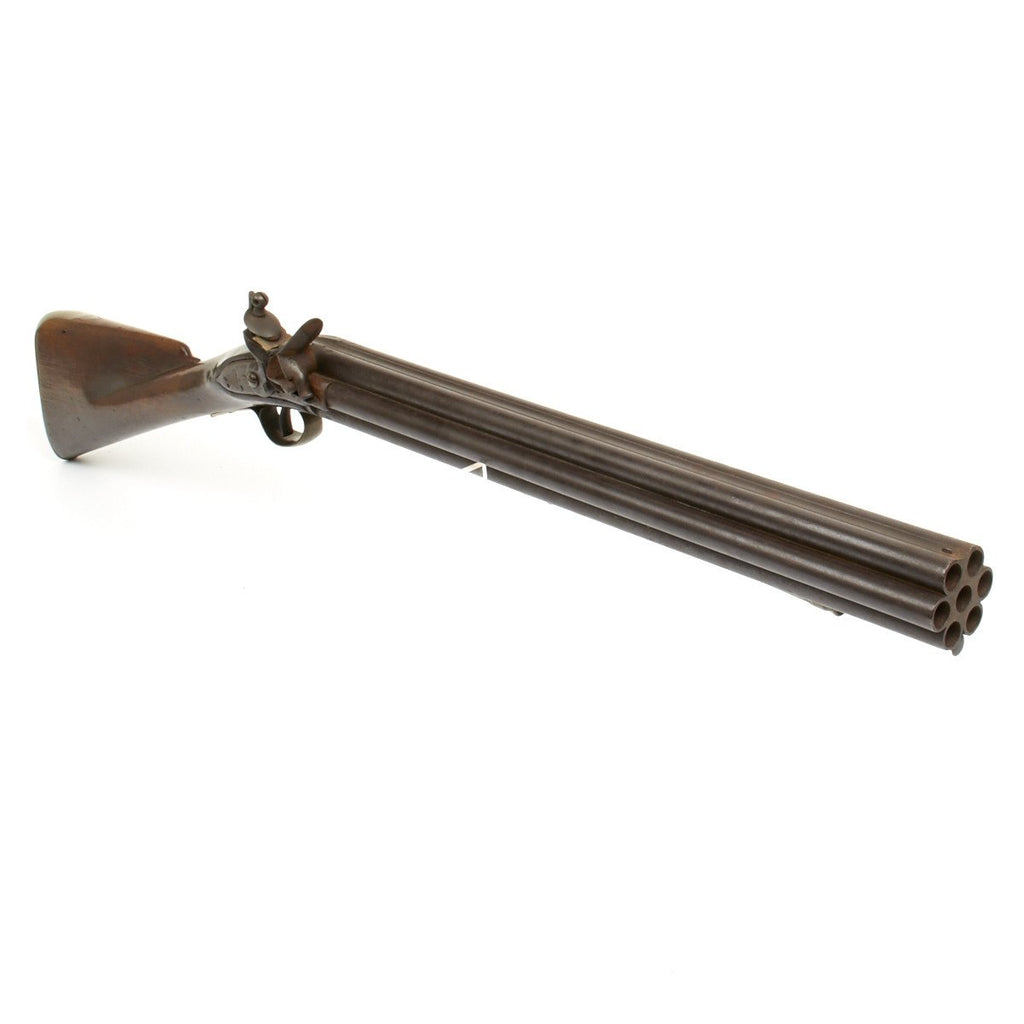-
Original Item: Only One Available. This wonderful example of the second model smooth bore Nock Volley gun is fully functional. It is nicely marked TOWER with a Crown G.R. on the lock plate. All barrels show British proof marks. It is comprised of all original parts and offered in excellent condition. This is the finest example to be offered on the market in decades.
The Nock gun was a seven-barrel flintlock smoothbore firearm used by the Royal Navy during the early stages of the Napoleonic Wars. It is a type of volley gun adapted for ship-to-ship fighting, but was limited in its use because of the powerful recoil and eventually discontinued.
Watch Alex evaluate and fire it on History Channel's Pawn Stars!
History and design:The weapon was invented by British engineer James Wilson in 1779, and named after Henry Nock, the London-based gun maker contracted to build the gun. It was intended to be fired from the rigging of Royal Navy warships onto the deck in the event that the ship was boarded by enemy sailors. Theoretically, the simultaneous discharge of seven barrels would have devastating effect on the tightly packed groups of enemy sailors.
The volley gun consisted of seven barrels welded together, with small vents drilled through from the central barrel to the other six barrels clustered around it. The central barrel screwed onto a hollow spigot which formed the chamber and was connected to the vent.
The gun operated using a standard flintlock mechanism, with the priming gunpowder igniting the central charge via a small vent. When the flash reached the central chamber, all seven charges ignited at once, firing more or less simultaneously.
The first models featured rifled barrels, but this made loading a long and cumbersome process, resulting in all following models being manufactured with smoothbore barrels.
Deployment and use:
During the early stages of the Napoleonic Wars, 500 Nock guns were purchased by the Royal Navy. However, attempts to use the gun during combat quickly revealed design flaws. The recoil caused by all seven barrels firing at once was more powerful than had been thought, and frequently injured or broke the shoulder of whoever was firing the gun, and in any case made the gun very difficult to aim and control. Furthermore, officers were reluctant to issue the guns during battle out of fear that the discharge flames would set fire to the surrounding rigging and sails. The few models purchased by the Royal Navy were removed from service in 1804.
Examples are available for public viewing reside at the York Castle Museum, the Hollywood Guns exhibit at the National Firearms Museum, the Royal Armouries Museum, and the Charleston Museum in South Carolina.
Production Life:
The gun was placed into production with the well-known firm of Henry Nock of London in 1780, and by 1787 a total of 608 were manufactured in at least two different series. Part flame-thrower, part sawed-off shotgun, all crazy, the Nock never gained widespread acceptance.
Popular culture
The Nock gun was brought to modern attention in the 1960 film The Alamo in which one is used by actor Richard Widmark, playing Jim Bowie. Th gun used in the film is now in the National Firearms Museum. In Bernard Cornwell's series of historical novels featuring fictional British soldier Richard Sharpe and, more recently, in the Sharpe TV series, Nock guns are used by Sharpe himself, the character Patrick Harper (a strong, burly man), and Royal Navy crewmen.
NOTE: International orders of antique firearms MUST be shipped using UPS WW Services (courier). USPS Priority Mail international will not accept these.
- This product is available for international shipping.
- Not eligible for payment with Paypal or Amazon
- IMA considers all of our antique guns as non-firing, inoperable and/or inert. Title 18, U.S. Code, Section 921(a)(16) defines antique firearms as all guns made prior to 1899. This law exempts antique firearms from any form of gun control or special engineering because they are not legally considered firearms. No FFL, C&R or any license is required to posses, transport, sell or trade Antique guns. All rifles and muskets sold by IMA that were manufactured prior to 1899 are considered Antiques by the US BATF (United States Bureau of Alcohol, Tobacco & Firearms). Therefore, all of IMA's Antique guns may be shipped to all US States and most nations around the world.
These antique guns are not sold in live condition. They are sold as collector’s items or as wall hangers. Any attempt at restoring an antique gun to be operational is strongly discouraged and is done so at the risk of the customer. By purchasing an antique gun from IMA you thereby release IMA, its employees and corporate officers from any and all liability associated with use of our Antique guns.
Pre-1899 Manufacture, no licenses required, allowed to ship to almost any deliverable address across the globe. Please note that for international shipping, these MUST be shipped using UPS WW Services.


We Buy Military Antiques
Our team expert buyers travels the world to pay fair prices for entire estate collections to singular items.
START SELLING TODAY













































